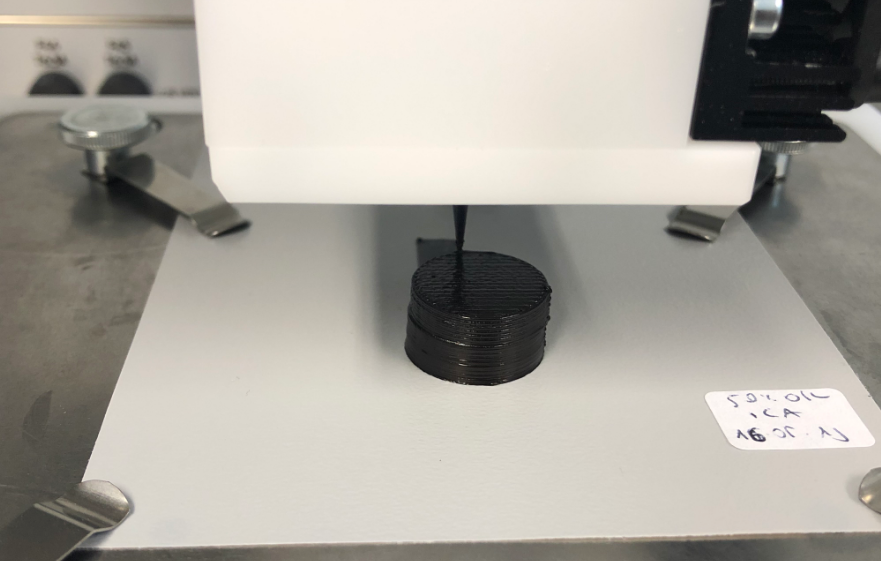Researchers from the Department of Forest Biomaterials at the University of Freiburg (UCF) have developed a novel environmentally-friendly wood-based 3D printing material.
The team, headed by UCF’s Professor Marie-Pierre Laborie, combined lignin, a chemical that provides strength to plant cell walls, with cellulose balls to create a novel biosynthetic polymer. As Lignen is produced endlessly by plants to protect themselves from predators, the team’s creation could represent a sustainable new printing material for use within light construction or industrial applications.

Liquid Crystalline Polymer 3D printing materials
Liquid Crystalline Polymers (LCPs), which are created by blending rod-like polymers with flexible coil plastics, are a well-established group of strong, lightweight molecular composites. As research has begun to shift towards the development of sustainable materials, LCPs have increasingly been blended with biogenic polymers in an attempt to create an eco-friendly resin.
In studies carried out by the Freiburg team earlier this year, they added Organosolv Lignin (OSL) to Hydroxypropyl Cellulose (HPC), and the effect of inserting Lignen into the mix was profound. Adding Lignen significantly improved the stability of the shear-induced transient band, enabling the creation of strong, highly-oriented, ductile films via shear casting.
Chemical crosslinking was later found to reinforce the integrity of the OSL-HPC mix, and improve its water solubility drawbacks, but both at the cost of its eco-friendly credentials. As a result, the challenge remains to develop sustainable bio-based crosslinkers that turn the polymers into insoluble Liquid Crystalline polymer (LC) networks.
Previous researchers have managed to achieve further crosslinking via radiation and esterification, but again, these weren’t bio-based solutions. In order to produce an LCE with the desired characteristics, the Freiburg team proposed using polyfunctional carboxylic acids, a known crosslinking agent for carbohydrates, to reinforce the polymer.

The Freiburg team’s wood-based biomaterial
Compared with those produced using the shear casting process, additive manufactured LCPs were expected to feature a higher orientation level, and be more material efficient. From the outset then, the researchers set out to develop a material that was compatible with both Direct Ink Writing (DIW) and Fused Deposition Modelling (FDM) 3D printers.
To create their novel lignen-based polymer, the research team dissolved the HPC and OSL powder separately in acetic acid, before storing them in darkness for two days. The solutions were summarily mixed with a constant HPC/OSL ratio of 4:1 (w/w) and kept sealed for another five days. After the crosslinking agents and glycerol-citric acid had been added, the concoction was mixed and centrifuged, yielding the researchers’ 3D printing polymer.
Solubility testing in deionized water showed that postcuring had a significant effect on the chemical behaviour of the material. Non-cured samples disintegrated within a few minutes when exposed to water, while cured samples were completely insoluble, demonstrating the importance of crosslinking to network formation.
Rheological analysis was later carried out on deposited filament to assess the structural integrity of 3D printed components during solidification. Results showed that materials containing higher levels of lignen displayed less compliance, which was more conducive to post-printing stability. As a result, lignen, the second most abundant biopolymer in the world, had proven itself as the key ingredient in creating usable and sustainable LCPs.
The Freiburg team concluded that they had successfully demonstrated eco-friendly HPC/OSL blends that, unlike previous LCPs, had a locked supramolecular arrangement. Although the researchers had optimized their solution for 3D printed parts, they conceded that further improvements were needed to solidify the fabricated structures for end-use architectural applications.
Making additive manufacturing more sustainable
A number of universities and organizations are currently working on ways to make 3D printing more environmentally-friendly.
Scientists from the Lithuania-based Vilnius University and the Kaunas University of Technology have developed a recyclable resin for Optical 3D printing (O3P). The new biomaterial is designed to move O3DP manufacturing towards bio-based resins, instead of non-recyclable petroleum-derived photopolymers.
Equispheres, a metal powder manufacturer, has received $8 million from Sustainable Development Technology Canada (SDTC) to create sustainable 3D printing powders. Independent tests verified that the materials were quicker to produce, and featured improved mechanical performance, compared to conventional powders.
Polish company Amazemet has launched an ultrasonic atomizer which is capable of creating powdered feedstocks from a variety of different source materials. Using the device, 3D printing waste can easily be reprocessed and recycled into fine metal powders.
The researchers’ findings are detailed in their paper titled “Lignin in Bio-Based Liquid Crystalline Network Material with Potential for Direct Ink Writing,” which was published in the ACS Applied Bio Materials journal. The report was co-authored by F. Robert Gleuwitz, Gopakumar Sivasankarapillai, Gilberto Siqueira, Christian Friedrich and Marie-Pierre G. Laborie.
Nominations for the 2020 3D Printing Industry Awards are still open, let us know who is leading the industry now.
The fourth edition of the 3D Printing Industry Awards Trophy Design Competition is now underway. Enter your design for the chance to win a CraftBot Flow 3D printer.
To stay up to date with the latest 3D printing news, don’t forget to subscribe to the 3D Printing Industry newsletter or follow us on Twitter or liking our page on Facebook.
Are you looking for a job in the additive manufacturing industry? Visit 3D Printing Jobs for a selection of roles in the industry.
Featured image shows the DIW 3D printing technique used by the Freiburg team to assess the integrity of their novel biomaterial. Image via Lisa Ebers, Freiburg University.



